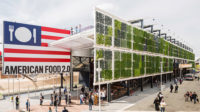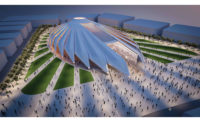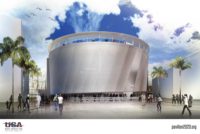The U.S. government, which has had a spotty record of participation in World Expos, is hoping to make a strong showing in Milan, where an eco-themed fair will open on May 1, 2015. In late July, the State Department issued a request for proposals for a U.S. pavilion, which would be privately funded and would occupy most of a 30,000-square-foot site. The U.S. would be joining some 130 other countries that have signaled their intentions to appear at the Expo. ("Registered" expos, sanctioned by the Paris-based Bureau of International Expositions, occur once every five years. The U.S. mounted respectable, but not stellar, pavilions in Aichi, Japan, in 2005 and Shanghai in 2010.)
The fair will occupy a site northwest of Milan, near the Massimiliano Fuksas-designed Fiera Milano convention center. Its theme is "Feeding the Planet, Energy for Life," which is one reason the RFP suggests that the U.S. pavilion include a "a food demonstration or exhibition." (It must also include a gift shop and a VIP hospitality area.) Proposers are expected to include plans for raising the projected $25 to $45 million cost of building, running, and then razing the pavilion. Though drawings are not required—the RFP is not a design competition—proposers can include renderings, according to Barry Levin of the State Department's Bureau of European and Eurasian Affairs. Proposals are due on September 15, just over six weeks from the date the RFP was issued, a seemingly impossible deadline for any firm without deep pockets and expo experience. (A similar process for 2010 produced a workaday U.S. pavilion by Clive Grout, a Vancouver architect.)
Some countries, especially those whose governments fund pavilions directly, chose designs through open competitions. Italy ran a competition last spring and chose a team led by Nemesi Studio of Rome. Germany’s team includes the architecture firm Schmidhuber, with Milla & Partner and Nüssli. Switzerland selected Netwerch GmbH of Brugg, to design a pavilion around grain silos; expo visitors will be invited to take food home with them as an experiment in managing scarcity. Expect ambitious pavilions from Dubai, Russia, Turkey, and Brazil, all of which are vying to host the 2020 Expo.
As in Shanghai and Aichi, there will be corporate pavilions as well. Vanke, a Chinese construction and real estate behemoth (headquartered in Steven Holl’s Horizontal Skyscraper in Shenzhen), has chosen Daniel Libeskind to design its pavilion.
The fairgrounds themselves were master-planned by a team that included Ricky Burdett, the London School of Economics urban planner, Jacques Herzog of Herzog and de Meuron, and Stefano Boeri, the Italian architect and magazine editor. Though the official theme is food, design should be a strong element of any fair in Milan, where world’s largest first furniture fair—the Salone Internazionale del Mobile di Milano—has been a mainstay since 1961.







Post a comment to this article
Report Abusive Comment